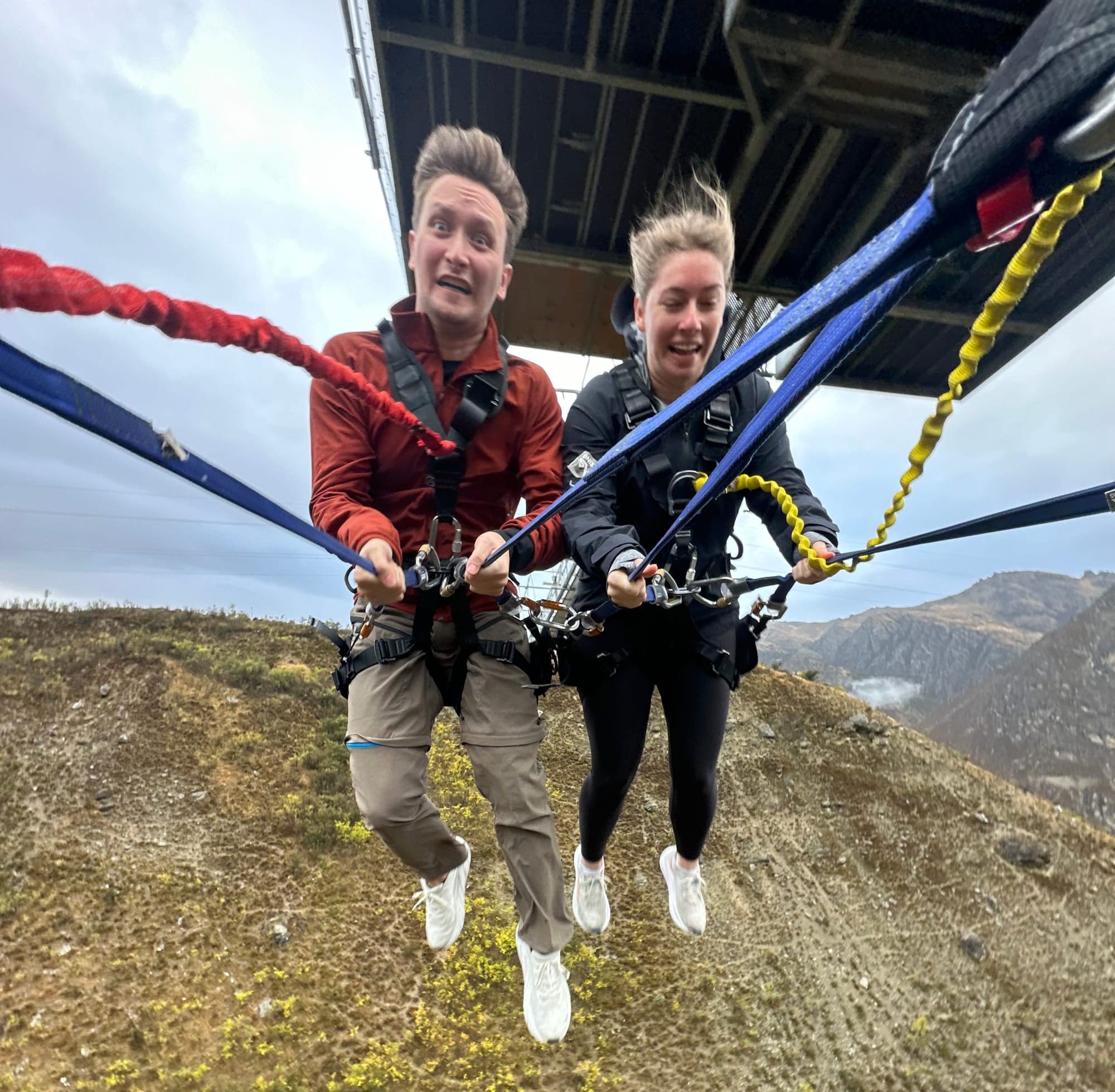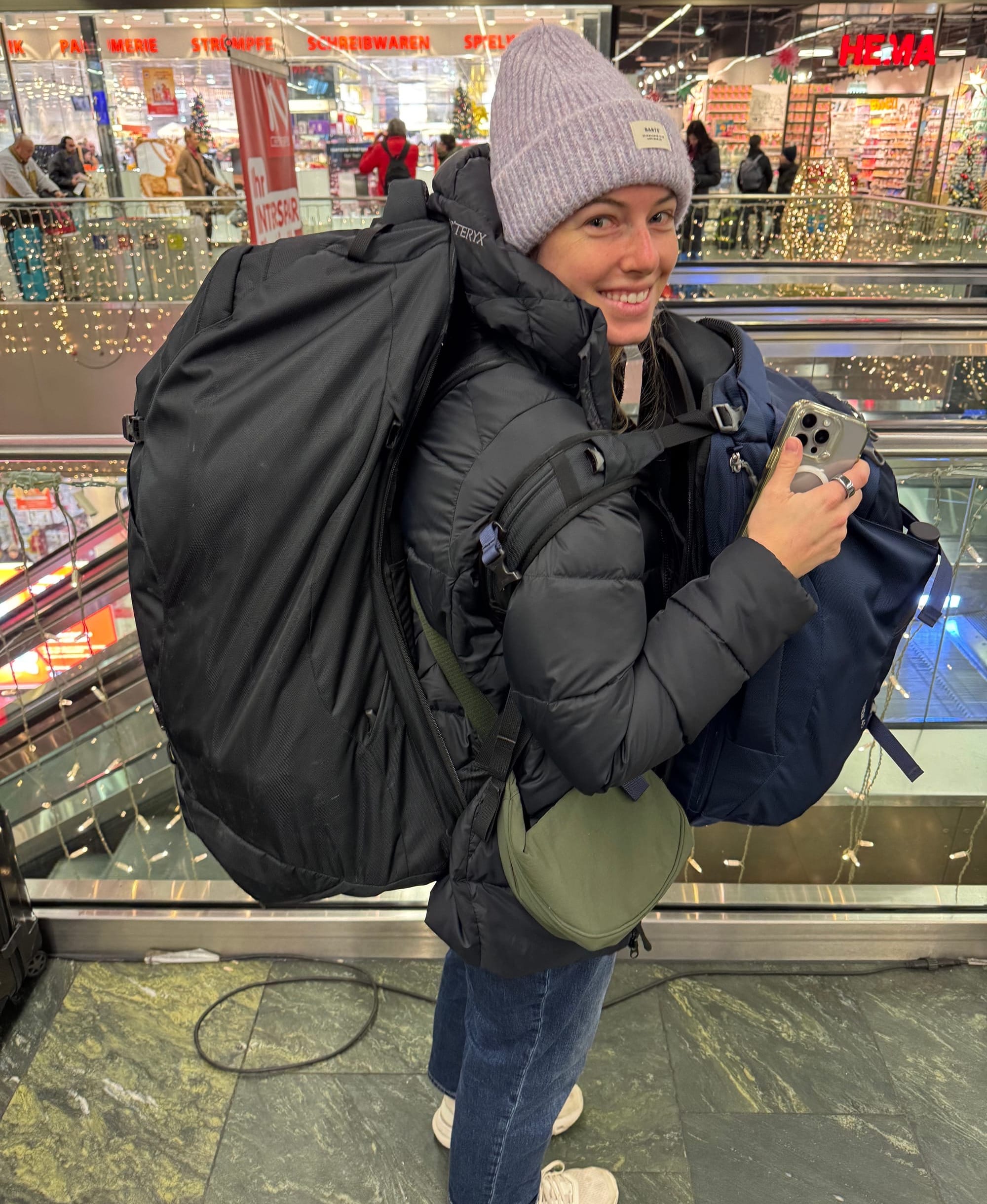"Oh no, I fink I broke my toof"
A short post on travel insurance and traveling with items that help when your 30s are coming at you fast. We still we have other things to share and finish writing via the blog, but after trying to file an insurance claim, this was the post that Tyler decided to get out the door on our most recent flight.
As a fun little game, keep a running count of the injuries on Tyler’s side vs. Makenna’s side.
Before we kicked off our sabbatical, one of the things we were debating was what to bring with us in case anything was to go awry. After all, it was only 2 weeks before we left when Tyler was on a run, tripped on some steps, and required bandaged shins for the next 4 weeks.
Plus, sometimes life has you feeling like this, i.e., hanging on for dear life and wondering how big the medical bill might be:

We’ll tell you what we ended up using and were thankful that we brought and then share some of the excess purchases.
What we used
Starting out with essentials that we are very thankful we brought with us: a set of medications in case getting to a doctor would have been difficult, inconvenient, or time sensitive. Obviously there are pharmacies all over the world, but my goodness were we happy to have Zofran to ease food poisoning, Imodium for bouts of traveler's diarrhea, broad spectrum antibiotics for a one time occurence of gastroenteritis, and over the counter (OTC) painkillers for headaches/migraines or when Tyler failed to address his caffeine addiction. These weren’t frequent occurrences or needs, but that little medicine pack we’ve circumnavigated the globe with twice now has certainly gotten its fair share of usage.
Some essentials will vary person to person, e.g., Tyler desperately needs a mix of OTC and prescription allergy medicine around tax season (it’s the springtime pollen, not the IRS that sets him off), but we also found some basic bandage and wound care to be helpful if you’re engaging in any adventure oriented activities like rock climbing, mountain biking, or above moderate level hiking.
Beyond medicine, we also looked into vaccinations, travel insurance, and private insurance within the US while we were away for the year.
A bit of excess
We didn’t quite know where we were going when we started. We had a grand plan to hit every continent without many limitations so when we shared our vague overarching plan with a travel doctor in NYC, he recommended about $6k worth of vaccines for each of us. We didn’t go for all of them (like "chikungunya"; yes it’s a real thing), but we certainly got more than we needed in hindsight.
Nonetheless, we’re now ready to go to battle against Yellow Fever, Japanese encephalitis (darn you mosquitos), rabies, and a handful of other diseases we don’t think about often within the US. Unfortunately, even when we were on our old corporate insurance, most of these weren’t covered within the US because they were considered exotic and unnecessary, so this chewed into our travel budget quickly out of the gates.
Speaking of insurance, turns out it’s a real pain in the rear when you don’t have the cushy corporate default to lean on. Travel insurance through Genki (similar to SafetyWing or major providers) ran us just under $250/month/person and (unsurprisingly) came with serious limitations for any travel within the US and Canada. We stuck to just that when we first started, figuring we’d only be in the States for roughly one month during our sabbatical (Genki offered limited support up to 30 days within the US on an annual basis).
Welp, fast forward ~6 months into our travels, and Tyler ended up needing an unexpected hernia repair surgery, in northern Vietnam. Woof.
Fortunately, it all happened during the open enrollment window for healthcare in the US and he was able to sign up for private insurance (thank you Affordable Care Act) back in the states for another ~$550/month/person. We went back to the states for surgery rather than trying to roll the dice abroad. It also allowed us to schedule it fairly quickly with a doctor Tyler’s parents knew well and trusted.
Tyler is fine now—everything went smoothly, but we now had an additional $1k in cost per month running against our budget for stateside insurance, not including the deductible he paid for the surgery. Not quite planned and certainly not cheap.
Fast forward again, ~4 days back into travel after the surgery and we were enjoying a lovely dinner in Singapore. One wrong bite, and this is an actual quote: “oh fucc, I fink I broke my toof….”
Sure enough, somehow, and we still genuinely don’t understand how this happened, Tyler did indeed fracture his tooth on a stray bite of sautéed vegetables. Unbelievable.
Thankfully our next stop was New Zealand in ~48 hours. After re-arranging some activities in Auckland, Tyler saw a dentist at an aptly named office called “The Tooth Company.” A root canal was scheduled and he rode out the cracked and annoying painful broken tooth for the rest of New Zealand until we could return to Auckland to spend another $1k. Fantastic dental care, but despite having both stateside insurance and travel insurance, dental care is one of those sneaky loop holes where you might not be fully covered for treatment abroad (shakes fist in the air).

Anyway, we’re almost back to the states, and injury free (knock on wood) and our two cents on being medically prepared for a year-long travel sabbatical boils down to this:
1. Medicine to haul around
Bring some basic OTC medications that cover recreational pain (headaches or small tumbles). For us, a small bottle of Tylenol, Ibuprofen, and Excedrin was a tried and true staple for periodic usage.
Talk to your doctor to see if you can get a few prescriptions to cover common situations while traveling abroad (food poisoning, traveler's diarrhea, stomach bugs, etc.). For us, that included Zofran, Z-Packs, and some prescription allergy meds.
As an aside, if you do find yourself seriously dehydrated or with an overly sensitive stomach after illness, a small supply of energy Gu’s/chews (think: running or endurance athlete supplements) were remarkably handy to keep electrolytes in check and to bring a surge of energy back to our bodies.
2. Specific destination medicines and vaccines
Talk to your doc (ideally a month or two ahead of leaving) about the list of places you intend to travel to. They’ll have recommendations for associated vaccinations and prescriptions but be cautious about saying “I want to go everywhere.” That’s how we ended up with more vaccines, prescriptions, and up-front cost than we needed. That said, some common ones include Diamox for altitude sickness on climbs or stays north of 15k+ feet, malaria for high-risk areas, Hepatitis and Tetanus boosters, etc.
We overestimated everywhere we could travel in 12 months and now have a large surplus of malaria, altitude sickness, and motion sickness meds.
The earlier you do this in your planning process before you leave, the easier it’ll be. Some vaccines like tetanus boosters might be included on your insurance, which is worth checking, but obviously requires time and is difficult to do ~1 week before you leave.
3. Basic wound care supplies (optional)
Consider bringing a small first aid kid for basic wound care (you can get this everywhere in the world; we just found it helpful to have on us for immediate treatment). Neosporin, band-aids, and some simple wraps and skin tape for larger wounds worked wonders for us.
4. Insurance, Emergency Budget, and Mindset
Given everything we encountered, we’d recommend travel insurance. You never know what will happen and while our circumstances were relatively easy to manage and we’d wager insurance got more from us than we got from them, we heard (and saw) some horror stories that were not so pleasant where the tables might have been turned.
Even with insurance, make sure you still maintain an emergency budget aside from your main travel fund. If you do have a major curve ball thrown your way (e.g., surgery), it’s helpful to not have that chew into your travel budget.
Last but not least, stay optimistic! We (read: Tyler) had our fair share of medical mishaps along the way, but with a bit of preparation, financial cushion, and a good spirit about all of it, we weathered the storm just fine throughout the year.
P.S. a few special shoutouts from Tyler:
- Akshi: thanks for being my impromptu remote dentist from Singapore and New Zealand in a pinch and to validate some of the confusion from the x-rays.
- Mom/Poppop: just as you’ve been my default and go-to medical professionals for the last 31 years (nurse anesthetist and surgeon for any readers), thank you for always being a phone call away to validate quite literally anything medical I toss your way on this trip.
- Makenna: thank you for acting as my unofficial nurse more than once throughout this trip. You were a godsend on many occasions when I was keeled over in the bathroom, couldn’t carry my fully loaded bags with the hernia, and just generally needing a bit of TLC on a rough day.

(Since this gets posted to the internet, we’re obligated to say none of this is medical advice and you should absolutely talk to your doctor about your plan, medicines, and anything related to your personal circumstances. This post was written to share our story.)